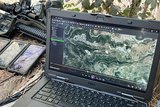Augmented reality applications inch closer
British BAE Systems engineers are working with the University of Birmingham to develop augmented reality applications, the company announced on 11 May.
The applications being collaborated on include a briefcase-sized portable command centre for emergency scenarios that creates a virtual workspace. It uses commercial technology to create a semi-virtual environment, and users can use a virtual reality headset and interactive gloves to interface with the mixed reality control station that appears around them. Users can monitor situations, zoom in and manipulate environments, direct troops and pull in virtual video screens that allow them to monitor news channels and feeds from UAVs.
BAE Systems and the university are also working to develop a virtual cockpit that provides infinitely reconfigurable virtual displays and controls, allowing pilots to customise their interface with the aircraft based on their preferences, mission objectives and task at hand. The technology is designed to be easily upgraded and customised.
Nick Colosimo, futurist, BAE Systems, said: 'We’re already seeing virtual and augmented reality becoming more commonplace in consumer products, and the possibilities it offers the armed forces are hugely exciting. Our unique approach will identify the optimal balance between the real world and the virtual – enhancing the user’s situational awareness to provide battle-winning and life-saving tools and insights wherever they may be.
'Through collaborating with the University of Birmingham, we are able to bring together some of the best minds available in this subject area to develop these concepts and evolve the technology itself.'
Bob Stone, simulation & human factors specialist, University of Birmingham, said: 'Being able to physically manipulate virtual objects in the real world has been challenging scientists for 40 years. Since my first virtual reality experience at NASA nearly 30 years ago, the technology has evolved from the primitive head-mounted displays and computers to today's world where we can interact with complex virtual objects, integrated in real-time with real-world scenarios.
'Our work with BAE Systems shows just how close we are to delivering the next generation of advanced mixed reality interfaces for future applications not only in defence, but also in such important domains as engineering and healthcare.'
More from Digital Battlespace
-
![Babcock nears first customer for Nomad AI translation tool]()
Babcock nears first customer for Nomad AI translation tool
Nomad can provide militaries with real-time intelligence, saving critical time on the battlefield.
-
![AUSA 2025: Israel’s Asio Technologies to supply hundreds of improved Taurus tactical systems]()
AUSA 2025: Israel’s Asio Technologies to supply hundreds of improved Taurus tactical systems
Taurus operates alongside the Israel Defense Forces’ Orion system which supports mission management across tens of thousands of manoeuvring forces, from squad leaders to battalion commanders.
-
![AUSA 2025: Kopin pushes micro-LED plans as China moves faster]()
AUSA 2025: Kopin pushes micro-LED plans as China moves faster
The plan for the new displays follows fresh investment in Kopin’s European facilities by Theon and an order for head-up displays in fielded aircraft, with funding from the US Department of Defense.
-
![AUSA 2025: Persistent Systems to complete its largest order by year’s end]()
AUSA 2025: Persistent Systems to complete its largest order by year’s end
Persistent Systems received its largest ever single order for its MPU5 devices and other systems earlier this month and has already delivered the 50 units to the US Army’s 4th Infantry Division.
-
![Aselsan brings in dozens of companies and systems under the Steel Dome umbrella]()
Aselsan brings in dozens of companies and systems under the Steel Dome umbrella
Turkey has joined the family of countries attempting to establish a multilayered air defence system with government approval in August 2024 for the effort landed by Aselsan. Dubbed Steel Dome, the programme joins Israel’s Iron Dome, the US Golden Dome, India’s Mission Sudarshan Chakra and South Korea’s low-altitude missile defence system.
-
![DSEI 2025: MARSS unveils new agnostic multidomain C4 system]()
DSEI 2025: MARSS unveils new agnostic multidomain C4 system
MARSS’ NiDAR system has been deployed using sensors from static platforms to provide detection and protection for static sights, such as critical infrastructure, ports and military bases.




























